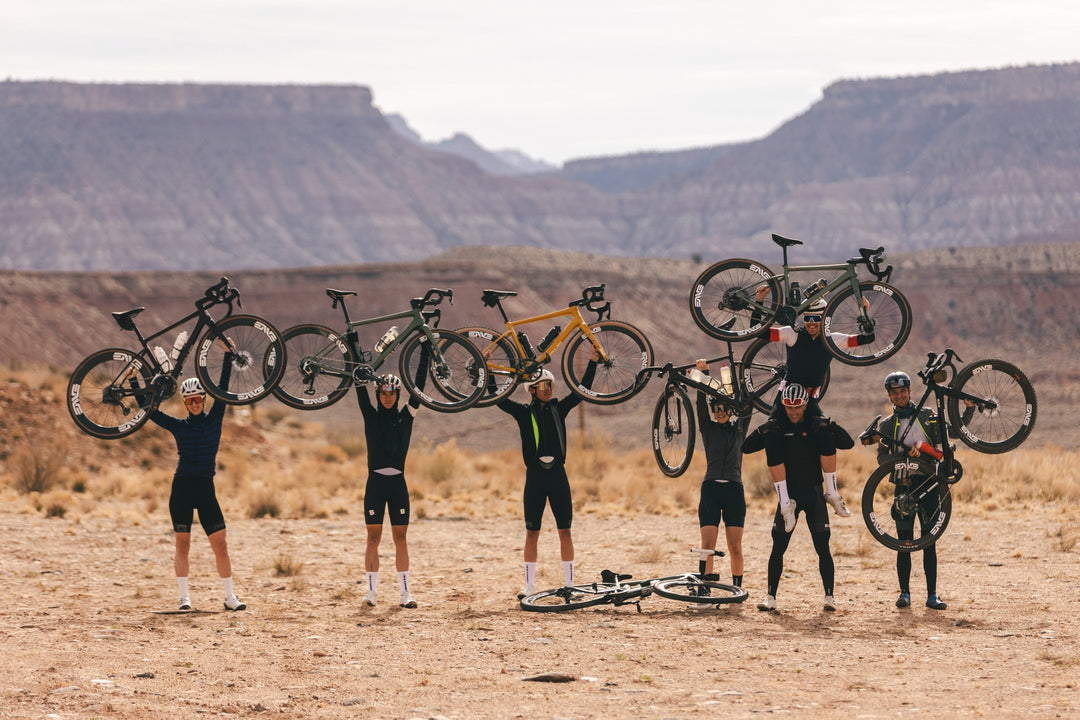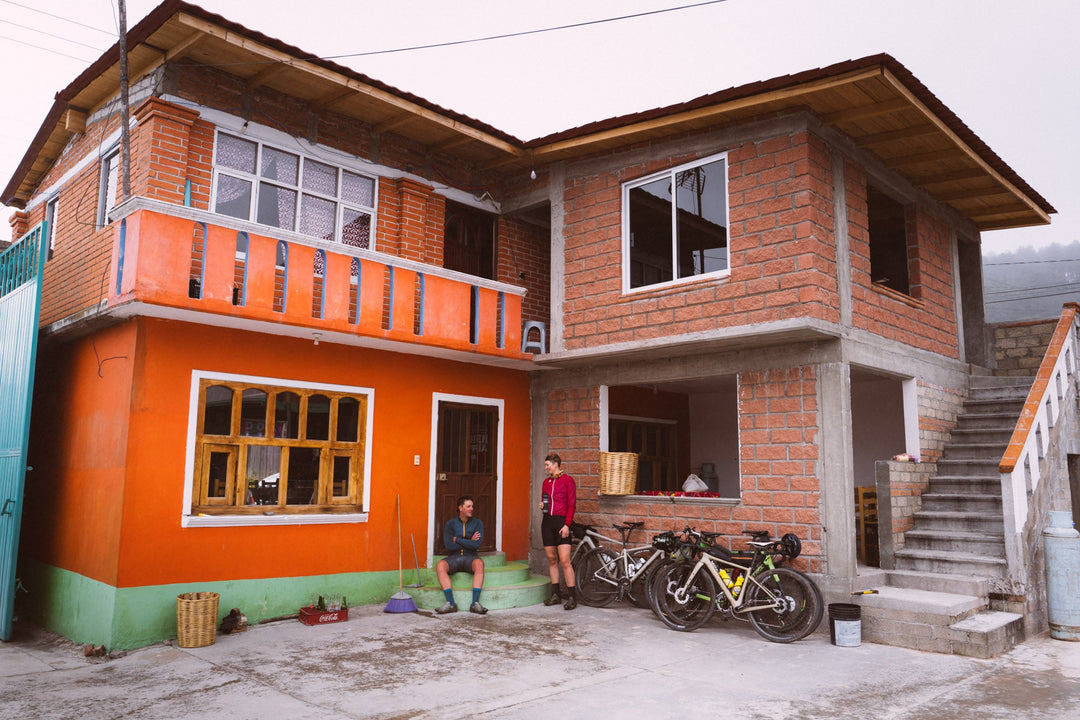The New Oregon Trail
Photos By Adam Lapierre
What’s a little sand, cold weather, and maybe even some snow drifts when you’re talking about a gravel adventure? The inaugural 5-day Oregon Trail Gravel Grinder took the whole gravel scene by storm with point-to-point stages challenging riders on terrain that stretched their abilities while covering a historic route where few cyclists had previously ventured. Add in a rolling circus of tents, food, showers, live music, and games to support those riders, and the Oregon Trail Gravel Grinder created a big stir in the gravel community. We asked three riders who took part for their experience and words of wisdom. Each had their own unique perspective and equipment setups. Here’s what they had to say.
SARAH MAX- WOMEN’S 3RD OVERALL
“The Oregon Trail Gravel Grinder was definitely unlike any other event I’ve done. The fact that it was a point-to-point gravel stage race covering some pretty remote parts of Oregon made it pretty special, and a little daunting. The riding was challenging, for sure, but the logistics added a whole other component.
“This first struck me when I picked up my bin at registration and stuffed it with everything I’d need to live and race for five days. At the end of each day’s stage, we’d pick up our bins and create some sense of place in our tents. Then, each morning we’d cram everything into the bins again, load them onto trucks, and repeat the routine many hours later. This quickly created a sense of community–and sharing meals in circa-1960 school gymnasiums and sleeping a couple of feet away from people certainly helped.
“As for the actual riding, Oregon is known for its different microclimates, and this event certainly covered it all. The first stage took us through deep sand and lava rock outside of Sisters, to the other side of the Cascades and into the lush forest near the McKenzie River. The second stage, which was supposed to be an easier day, proved the most challenging for many of us. While climbing nearly 6,000 feet from the McKenzie we ran into cold rain and snow flurries and then needed to descend down the other side to Oakridge. Brrrrr.
“Meanwhile, what was supposed to be the hardest day, 75 miles and 9,400 feet of climbing from Oakridge to Gilchrist on day three proved to be a crowd favorite, thanks largely to a fun technical section on a historic wagon road. The fourth day, from Gilchrist to LaPine, skirting Paulina Peak gave everyone a real taste of riding in the High Desert.
“The fifth and final day, from LaPine to Sisters via Bend, was the only day I could claim local knowledge. Up until then, every road was completely new to me, which is a testament to how much thought the organizers put into the routes, and everything.
“Seriously, it was such a cool event, and kudos on the organizers and volunteers. Considering it was the first year, a ton could have gone wrong, but they pretty much nailed everything.”




JESSE MOORE- 9TH OVERALL
“I can honestly say that I left this week a much better bike rider, not an easy feat when you’ve been riding bikes for most of your life. This was easily the most well-balanced race I’ve ever done in terms of the quiver of skills you had to possess. And if you were missing any you would get severely punished on one day or another.
“You had every type of surface and grade possible over the five days. There were short punchy climbs to go with long alpine ones and even some good altitude at points. Then of course the ripping fast gravel descents from all of those climbs where the MTB folks put on multiple descending clinics for us roadies. We had warm weather, hypothermic rain, snow drifts and sand drifts, at times in the same day. The sand riding was some of the hardest for me, so deep and fine. The “moon dust” was more like riding in snow than sand; and you couldn’t see the people around you or in front of you, just blind faith and full throttle.
“It was kind of a mixed bag of some of the most remote and incredible terrain and scenery you’ve ever seen, often in old growth forest, punctuated by white knuckle fast and loose descents, sometimes preceded or followed by near blind sand slogs to test the resolve. I did a lot of vacillating between shit eating grin and under the breath cursing as I went nowhere in quicksand or bounced my way across some just terrible sections of road. As I said the race was well-balanced in every way, including emotionally!
“The food was fantastic in the mornings and evenings. Beer flowed well and the camping scene was pretty cool. I saw a lot of new friendships get started and in general I think a lot of good memories were forged in the crucible of shared suffering.”



KEVIN GIRKINS- DOUBLE STAGE WINNER AND 8TH OVERALL
“Considering this was a first year event I was a little worried about whether or not the race would be well organized and run smoothly, but I was blown away with the level of choreographed motions that fell into place each day. Chad Sperry didn’t just make sure that we had camping and food at the end of each day, he made sure it looked nice too! Drinks were served on top of a very nice stained wooden slab with oak barrels that were branded with the race’s emblem, they had corn hole boards set out every night that were also branded ‘Oregon Trail’ and everything had its place.
“I kind of had the feeling this was going to be different than the typical gravel race and more like a mountain bike race where there’s less drafting and more line choice. As it turns out, I was pretty damn close. Essentially, 15 miles into the start of day one and I was dropped and dropped hard. Not like ‘oh man if I kick it hard right here I can make back into the draft’ it was more like ‘how did they do that’, and ‘where did they go?’
“To say I was a bit outskilled by the level of athletes there would be an understatement. It wasn’t that they could just out-climb me or out-descend me or move through technical sections smoother than me, they could do all of those. I was a roadie in a mountain biker’s bunny slope playground. I think my only advantage was actual watts and relentlessly turning over the pedals. Besides that, ‘I really need to do some more push-ups’ was something I said pretty religiously after every day of racing.
“The real challenges of these five days for me was being out of my element. All too often I race in “arenas” that have some resemblance to a skillset I’ve obtained over the years. This race had none of those. I think the best day of this race was supposed to be the queen stage when I got dropped (on a descent) and said ‘screw this, I’m waiting for my friends.’ I sat at an aid station and ate sandwiches for 15 minutes. Once my friends were there it was all smiles and scenery; this would have never happened in a road stage race with a caravan, categories and time cuts. After one day of taking it easy, if you could call 10,000 feet of climbing easy, having fun and making stops to take pictures while appreciating the course instead of just hating it obviously made a difference for me. I can’t think of any other race I’ve done where that happened or I even had the opportunity to do that.
“After the race each day the weather was pretty peachy, 75-85 F and sunny. I’d grab my race designated ‘tote’ and pack a small bag with clean clothes, a toiletry bag and a towel. Then I’d find the nearest river which was never more than a mile away and go for an ice bath/swim (it seems that all rivers in Oregon feel like an ice bath). There were hot showers after each day for people, but something about taking in the natural river beauty seemed like a better idea. At the end of each day there was entertainment for the racers, games, live music and good river vibes. How many times have you finished a stage of a race and ended up watching TV in a hotel room thinking ‘I wish I had the energy to actually enjoy where I am.’ I love how Chad Sperry and Breakaway Promotions made this so different.”




KEVIN’S 7 TIPS FOR WOULD-BE OREGON TRAIL GRAVEL GRINDER RACERS
1. Ride your gravel bike on mountain bike trails! Descend on gravel roads and learn to become more diverse than just pedaling in circles. Maybe do some cyclocross racing this offseason specifically with this race in mind.
2. Sign up early! This race will fill up quickly and I have no doubt about it. It’s worth every penny and it’s not going to take long for word to spread about this.
3. Make sure you’re physically ready to suffer and mentally ready to have fun. I heard Allison Tetrick brought a flask of whiskey each day. Now that’s exactly what I’m talking about!
4. Do not crash. One of the beautiful things about this race is being able to continue to the next day and enjoy the festivities of each evening. If you can’t pedal your bike then you therefore have “dysentery” and must take the “bus of shame” back to Sisters.
5. Bring a good jacket! If you’re like me and from the south you need to bring a good jacket and gloves. During June in Oregon it gets below freezing at night and during the day you’re lucky to hit 80 degrees as a high.
6. Bring on the fatties! You’re not going to regret bringing tires that are 42c (like I rode) or bigger even. My ENVE G23 wheels with 42c tires made up for a lot of my mistakes and the days would have been a whole harder on anything else. I heard Carl Decker, the guy who smashed this race and won, put 50c tires on his gravel bike and shaved down the side knobs to make them fit in his stays. Smart man!
7. Get there early and stay late. Redmond airport is small so expect delays along with lots of logistics to figure out. I heard plenty of stories about people showing up the day of due to delayed flights or even missing the first stage start. Plan to arrive at least 24 hours before your start and I would even do more than that if possible.






















